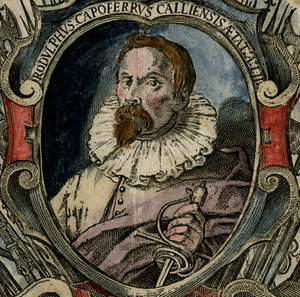|
|
You are not currently logged in. Are you accessing the unsecure (http) portal? Click here to switch to the secure portal. |
Difference between revisions of "Wiktenauer:Main page/Featured"
| (18 intermediate revisions by the same user not shown) | |||
| Line 1: | Line 1: | ||
| − | {{Infobox | + | {{Infobox writer |
| − | + | | name = [[Ridolfo Capo Ferro da Cagli]] | |
| − | | name | + | | image = File:Ridolfo Capo Ferro da Cagli portrait.png |
| − | | | + | | imagesize = 300px |
| + | | caption = | ||
| − | + | | pseudonym = | |
| − | | | + | | birthname = |
| − | | | + | | birthdate = 16th century |
| − | | | + | | birthplace = |
| + | | deathdate = 17th century | ||
| + | | deathplace = | ||
| + | | resting_place = | ||
| + | | occupation = [[Fencing master]] | ||
| + | | language = [[Italian]] | ||
| + | | nationality = | ||
| + | | ethnicity = | ||
| + | | citizenship = | ||
| + | | education = | ||
| + | | alma_mater = | ||
| + | | patron = Federico Ubaldo della Roevere | ||
| − | + | | period = | |
| − | | | + | | genre = [[Fencing manual]] |
| − | | | + | | subject = |
| − | | | + | | movement = |
| − | | | + | | notableworks = ''[[Gran Simulacro dell'Arte e dell'Uso della Scherma (Ridolfo Capo Ferro da Cagli)|Gran Simulacro dell'Arte e dell'Uso della<br/>Scherma]]'' (1610) |
| − | | | + | | manuscript(s) = |
| − | | | + | | principal manuscript(s)= |
| − | + | | first printed edition= | |
| − | | | + | | wiktenauer compilation by=[[Michael Chidester]] |
| − | | | + | |
| − | | | + | | spouse = |
| − | | | + | | partner = |
| − | + | | children = | |
| − | + | | relatives = | |
| − | + | | influences = [[Camillo Aggrippa]] | |
| − | + | | influenced = [[Sebastian Heußler]] | |
| + | | awards = | ||
| + | | signature = | ||
| + | | website = | ||
| + | | below = | ||
}} | }} | ||
| − | + | '''Ridolfo Capo Ferro da Cagli''' (Ridolfo Capoferro, Rodulphus Capoferrus) was a 17th century [[Italian]] [[fencing master]]. | |
| − | + | ||
| − | + | He seems to have been born in the town of Cagli in the Province of Pesaro e Urbino, and was a resident of Siena, Tuscany. Little is known about the life of this master, though the dedication to Federico Ubaldo della Roevere, the young son of Duke Francesco Maria Feltrio della Roevere, may indicate that he was associated with the court at Urbino in some capacity. The statement at the beginning of Capo Ferro's treatise describing him as a "master of the great German nation" likely signifies that he was faculty at the University of Siena, either holding a position analogous to dean of all German students, or perhaps merely the fencing master who taught the German students. | |
| − | + | ||
| − | + | At the age of 52, Capo Ferro authored a treatise on the [[rapier]] entitled ''[[Gran Simulacro dell'Arte e dell'Uso della Scherma (Ridolfo Capo Ferro da Cagli)|Gran Simulacro dell'Arte e dell'Uso della Scherma]]'' ("Great Representation of the Art and Use of Fencing"); it was published in Siena in 1610, but refers to Federico by the ducal title. Though this treatise is highly praised by modern fencing historians, it is neither comprehensive nor particularly innovative and does not seem to have been influential in its own time. | |
| − | |||
| − | |||
| − | |||
| − | |||
| − | |||
| − | |||
| − | |||
| − | ''''' | ||
| − | < | + | <h2> Treatise </h2> |
| − | + | This concordance uses the watercolor illustrations from the 1629 edition where they are available, except for a few in which the paint obscures the actual fencing actions. You can view all of the painted illustrations on the treatise page. | |
| − | + | ([[Ridolfo Capo Ferro da Cagli|Read more]]…) | |
| − | |||
<dl style="clear:right;"> | <dl style="clear:right;"> | ||
<dt style="font-size:90%;">Recently Featured:</dt> | <dt style="font-size:90%;">Recently Featured:</dt> | ||
| − | <dd style="font-size:90%;">[[ | + | <dd style="font-size:90%;">[[Nicoletto Giganti]] – [[Hans Talhoffer]] – [[Andre Lignitzer]] – [[Adam van Breen]] – [[Francesco Fernando Alfieri]]</dd> |
</dl> | </dl> | ||
Revision as of 04:48, 29 July 2020
| Ridolfo Capo Ferro da Cagli | |
|---|---|
 | |
| Born | 16th century |
| Died | 17th century |
| Occupation | Fencing master |
| Patron | Federico Ubaldo della Roevere |
| Influences | Camillo Aggrippa |
| Influenced | Sebastian Heußler |
| Genres | Fencing manual |
| Language | Italian |
| Notable work(s) | Gran Simulacro dell'Arte e dell'Uso della Scherma (1610) |
| Concordance by | Michael Chidester |
Ridolfo Capo Ferro da Cagli (Ridolfo Capoferro, Rodulphus Capoferrus) was a 17th century Italian fencing master.
He seems to have been born in the town of Cagli in the Province of Pesaro e Urbino, and was a resident of Siena, Tuscany. Little is known about the life of this master, though the dedication to Federico Ubaldo della Roevere, the young son of Duke Francesco Maria Feltrio della Roevere, may indicate that he was associated with the court at Urbino in some capacity. The statement at the beginning of Capo Ferro's treatise describing him as a "master of the great German nation" likely signifies that he was faculty at the University of Siena, either holding a position analogous to dean of all German students, or perhaps merely the fencing master who taught the German students.
At the age of 52, Capo Ferro authored a treatise on the rapier entitled Gran Simulacro dell'Arte e dell'Uso della Scherma ("Great Representation of the Art and Use of Fencing"); it was published in Siena in 1610, but refers to Federico by the ducal title. Though this treatise is highly praised by modern fencing historians, it is neither comprehensive nor particularly innovative and does not seem to have been influential in its own time.
Treatise
This concordance uses the watercolor illustrations from the 1629 edition where they are available, except for a few in which the paint obscures the actual fencing actions. You can view all of the painted illustrations on the treatise page.
(Read more…)
- Recently Featured:
- Nicoletto Giganti – Hans Talhoffer – Andre Lignitzer – Adam van Breen – Francesco Fernando Alfieri
